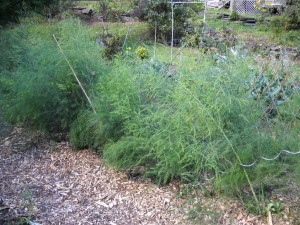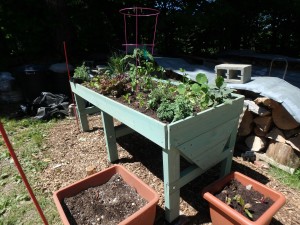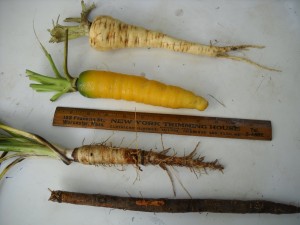It’s Not Too Late to Start an Herb Garden
Garden centers are mostly sold out of flowers and vegetables by now, but there seem to be plenty of herbs still for sale. Now that you have (hopefully) gotten your veggies and annual flowers planted, this is a good time to plant some herbs.
My vegetable garden –where I have always grown herbs – is somewhat remote from my house and down a set of stone steps. But this summer I have an herb garden between my car park and wood pile – just 10 steps or so from the house.
So how do I grow parsley, sage, rosemary and thyme (and others not included in Simon and Garfunkel’s song) in a spot that sounds so inhospitable? I am growing them in a wooden container called a VegTrug that I got from Gardeners Supply (www.gardeners.com). It’s big and deep: six feet long, 2 feet wide and up to 18 inches deep in the middle of the V-shaped container. It is on legs and stands 30 inches high. Very nice, no bending over.
Filling up the VegTrug with appropriate planting mix is important: you can’t just dig garden dirt and shovel it in. The soil would compact and the plants wouldn’t thrive. But it takes over 400 quarts of soil mix to fill this behemoth. To buy that much potting mix would be pricey.
Getting the mix right is important: you want your mix to stay fluffy, hold water and offer nutrients. But if you just used a standard commercial potting mix, your growing medium would need weekly infusions of liquid chemical fertilizer. Adding compost introduces organic matter and beneficial microorganisms that work with the roots of your plants to share nutrients from the compost and organic potting soil.
I buy good quality compost each year that a local contractor makes from cow barn scrapings that he turns and aerates and makes into lovely light-weight compost that is relatively weed free. I mixed that compost with peat moss, “Moo-Grow” (an organic potting soil), organic fertilizer, limestone, perlite and vermiculite.
Vermiculite is a fluffy material made from heat-expanded mica that holds water. It is used in most potting mixes, though you might not notice it. I also added perlite, another heat-expanded mineral. It looks like Styrofoam, but is great for containers: it has a neutral pH, holds water and air, does not deteriorate or compress. I used a total of 6 quarts of each in my VegTrug. Perlite and vermiculite go a long way.
To make my soil mix I used a 5-gallon pail to measure, adding roughly 2 parts of compost and 2 parts of Moo-Gro potting mix to one part of peat moss. I stirred up that mix in a huge garden cart. I added half a cup of limestone per bucket of peat moss to counteract the acidity.
Once the ingredients were mixed, I add Pro-Gro, an organic bagged fertilizer. I used a total of 2 quart containers of Pro-Gro in the 100-plus gallons of soil mix I made. I added one quart of Azomite, a source of diverse mineral micronutrients, in the total mix. Azomite is optional. You could add rock dust instead, if you can get some very fine rock powder from a tombstone maker or a rock quarry. Or you can leave it out altogether.
It is important to get the ingredients well moistened before adding them to the VegTrug. I did this by adding water from my hose to the mix, and stirring with a shovel. Dry peat moss can be very hard to moisten; I wet it, stirred it, let it sit, and repeated until it seemed evenly moist.
So what am I growing? In the middle, where the soil is deepest, I have a tomato plant, one I started from seed called ‘Summer Sunrise’. The seeds came from the Hudson Valley Seed Library (www.seeedlibrary.org and is suited for container growing.
What else? I have about a dozen lettuce plants, 3 flat-leafed parsley plants, 2 kinds of sage, a rosemary and a thyme plant. I dug up a chunk of chives from my garden, cut it back and planted it in the VegTrug. Marjoram and a nasturtium are doing well – the latter has edible flowers, and will flow out and over from the VegTrug.
I planted dill and arugula by seed – both are up and doing fine, though I also bought a small pot of dill at my local Food Coop – another good source for pots of herbs. Lastly I planted a 4-pack of small basil plants. Everything is thriving!
Watering is important for containers. This VegTrug has shallow soil near the edges, deeper soil towards the middle, so the edges dry out quicker. I find I need to give it 4 to 6 gallons in hot, sunny weather. It only gets sunshine from 9am to 3pm, but that seems adequate.
So whether you invest in a VegTrug from Gardeners Supply or just grow some herbs in pots on the porch, go plant some. I am so delighted with my herb garden I know I will plant it again every year. And the collection of herbs in this nice cedar container is pleasing to the eye as well as the taste buds!
Read Henry’s blogs at https://dailyuv.com/
End of Year Review
Recently I sent out an e-mail to a hundred or more readers of this column who had e-mailed me a question at some point. I wanted to see how people had done in 2012, and got lots of responses. I asked gardeners to respond to one or more of these prompts: In 2012 I was pleased to see that ….? I was surprised to see …? I was disappointed to see …?
 I’ll go first. I was pleased to see my new asparagus patch grew like crazy! I gave it lots of compost, some Pro-Gro organic fertilizer and a healthy dose of green sand. By fall I had 5 or more stems from each root, and most grew 3feet tall! My parsnips grew like crazy, as did onions … and all root crops.
I’ll go first. I was pleased to see my new asparagus patch grew like crazy! I gave it lots of compost, some Pro-Gro organic fertilizer and a healthy dose of green sand. By fall I had 5 or more stems from each root, and most grew 3feet tall! My parsnips grew like crazy, as did onions … and all root crops.
I was surprised to see how deeply my scorzonera (a first year for it) grew into the ground: 8-12 inches, even though each root was less than an inch in diameter. And each was a nearly perfect cylinder. It’s a lesser-known root crop, one that is cooked and eaten, not munched raw like carrots. It tasted good in the turkey stuffing or sautéed with other root vegetables. I was surprised that my beets grew so perfectly, even the ones that I had not thinned enough.
I was disappointed to see, once again, that various blights terminated my tomato harvest early. In the “old days” tomatoes kept on growing and producing fruit through September and into October. We covered them with blankets to keep the frost off them. But not anymore. Late blight finished them off by Labor Day. And of course, there was the impatiens downy mildew that killed impatiens off.
But many readers had great a great summer, due in part, to the sunny weather. Peg Sullivan wrote saying, “In 2012, I was pleased to see that everything I planted (and many things I didn’t!) grew beautifully. My gardens were full of color, flavor, and diversity and I didn’t have one crop failure or disappointment. I was pleasant surprised at the number of bees, butterflies and birds that visited my flower and herb gardens, and with a minor “high security” fence in my vegetable garden this year, I was able to fend off the pesky, but oh so comical woodchuck who hid under my zucchini leaves the prior year and demolished my kale crop. It was an incredible gardening season for me, and more of them like 2012 would be great!
Gary Milek of Cider Hill Gardens in Windsor, VT was surprised to see that he could eat fresh garden tomatoes in December. Last fall his wife, Sarah, pulled some ‘Juliet’ tomato plants that were loaded with green fruit and hung them upside in the garage, where they slowly ripened.
But many readers were disappointed by their losses to animals. Rebecca Tucker on the Black River in Springfield, VT wrote that “In 2012 I was disappointed in that, though I caught one woodchuck early in June in a hav-a-hart trap and delivered it to my neighbor for a stew, I spent the next two months trying to stay ahead of the second. … NEXT year, I’m building a chicken wire fence with a base of PT lumber buried 6 inches down all around the garden.” Many readers complained of the large numbers of mice and squirrels this year, probably due to the relatively snowless winter.
Reader Jan Polex noted that she was “Disappointed by the number of rabbits and what I needed to do to keep them out and also by my poor aim of my sling shot (was better last year)”.
Ruth Winkler of Cuttingsville, VT, among others, wrote that she “was disappointed in the fact that our apple trees this year did not provide us with any. The year before I had so many we were giving them away and I made lots of pies.” I think they will be back next summer – most of us had an unseasonably warm spell in April, followed by a hard frost that killed those buds that were already opening.
Brian Steinwand , recently retired, wrote that he was surprised by “how well some crops do in containers. I can grow a lot in a small amount of space, and even move some of those containers to follow the sun during the day.” I chuckle, thinking of Brian walking his tomatoes like a puppy on a leash! But more power to him! I’m not sure I will ever be able to do that – retire, that is.
Reader Daniel Duffy wrote, “In 2012 I was pleased to see that you were available when I had questions. I am a beginning gardener, just completing my second year. I have your book, Organic Gardening (Not Just) in the Northeast: A Hands-On Month-to-Month Guide, and it guided me Spring thru Fall, with tips, suggestions, guidelines which I was grateful to have. It was particularly useful because of its concentration on the Northeast. You also were kind enough to reply to my many E-mails sent to you. “ Thanks, Daniel. I don’t have the time to answer all questions, but I do try. My best wishes to all of you for the New Year. Let’s hope that next year will be even better than this year!
Wobar and the Quest for the Magic Calumet, Henry’s new children’s book, is available at his web site, www.henryhomeyer.com or your local bookstore. You may write Henry at P.O. Box 364, Cornish Flat, NH 03746 or e-mail him at henry.homeyer@comcast.net.




